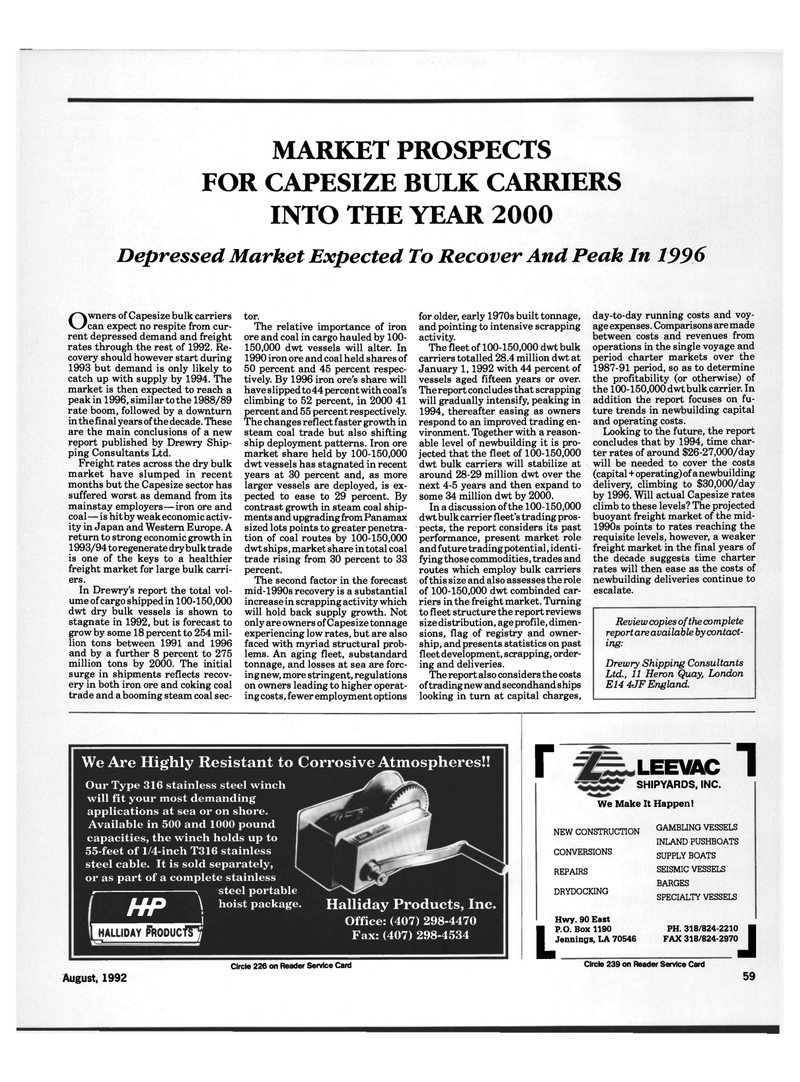
Page 57: of Maritime Reporter Magazine (August 1992)
Read this page in Pdf, Flash or Html5 edition of August 1992 Maritime Reporter Magazine
MARKET PROSPECTS
FOR CAPESIZE BULK CARRIERS
INTO THE YEAR 2000
Depressed Market Expected To Recover And Peak In 1996
Owners of Capesize bulk carriers can expect no respite from cur- rent depressed demand and freight rates through the rest of 1992. Re- covery should however start during 1993 but demand is only likely to catch up with supply by 1994. The market is then expected to reach a peak in 1996, similar to the 1988/89 rate boom, followed by a downturn in the final years of the decade. These are the main conclusions of a new report published by Drewry Ship- ping Consultants Ltd.
Freight rates across the dry bulk market have slumped in recent months but the Capesize sector has suffered worst as demand from its mainstay employers—iron ore and coal—is hit by weak economic activ- ity in Japan and Western Europe. A return to strong economic growth in 1993/94 to regenerate dry bulk trade is one of the keys to a healthier freight market for large bulk carri- ers.
In Drewry's report the total vol- ume of cargo shipped in 100-150,000 dwt dry bulk vessels is shown to stagnate in 1992, but is forecast to grow by some 18 percent to 254 mil- lion tons between 1991 and 1996 and by a further 8 percent to 275 million tons by 2000. The initial surge in shipments reflects recov- ery in both iron ore and coking coal trade and a booming steam coal sec- tor.
The relative importance of iron ore and coal in cargo hauled by 100- 150,000 dwt vessels will alter. In 1990 iron ore and coal held shares of 50 percent and 45 percent respec- tively. By 1996 iron ore's share will have slipped to 44 percent with coal's climbing to 52 percent, in 2000 41 percent and 55 percent respectively.
The changes reflect faster growth in steam coal trade but also shifting ship deployment patterns. Iron ore market share held by 100-150,000 dwt vessels has stagnated in recent years at 30 percent and, as more larger vessels are deployed, is ex- pected to ease to 29 percent. By contrast growth in steam coal ship- ments and upgrading from Panamax sized lots points to greater penetra- tion of coal routes by 100-150,000 dwt ships, market share in total coal trade rising from 30 percent to 33 percent.
The second factor in the forecast mid-1990s recovery is a substantial increase in scrapping activity which will hold back supply growth. Not only are owners of Capesize tonnage experiencing low rates, but are also faced with myriad structural prob- lems. An aging fleet, substandard tonnage, and losses at sea are forc- ing new, more stringent, regulations on owners leading to higher operat- ing costs, fewer employment options for older, early 1970s built tonnage, and pointing to intensive scrapping activity.
The fleet of 100-150,000 dwt bulk carriers totalled 28.4 million dwt at
January 1,1992 with 44 percent of vessels aged fifteen years or over.
The report concludes that scrapping will gradually intensify, peaking in 1994, thereafter easing as owners respond to an improved trading en- vironment. Together with a reason- able level of newbuilding it is pro- jected that the fleet of 100-150,000 dwt bulk carriers will stabilize at around 28-29 million dwt over the next 4-5 years and then expand to some 34 million dwt by 2000.
In a discussion of the 100-150,000 dwt bulk carrier fleet's trading pros- pects, the report considers its past performance, present market role and future tradingpotential, identi- fying those commodities, trades and routes which employ bulk carriers of this size and also assesses the role of 100-150,000 dwt combinded car- riers in the freight market. Turning to fleet structure the report reviews size distribution, age profile, dimen- sions, flag of registry and owner- ship, and presents statistics on past fleet development, scrapping, order- ing and deliveries.
The report also considers the costs of tradingnew and secondhand ships looking in turn at capital charges, day-to-day running costs and voy- age expenses. Comparisons are made between costs and revenues from operations in the single voyage and period charter markets over the 1987-91 period, so as to determine the profitability (or otherwise) of the 100-150,OOOdwt bulk carrier. In addition the report focuses on fu- ture trends in newbuilding capital and operating costs.
Looking to the future, the report concludes that by 1994, time char- ter rates of around $26-27,000/day will be needed to cover the costs (capital+operating) of a newbuilding delivery, climbing to $30,000/day by 1996. Will actual Capesize rates climb to these levels? The projected buoyant freight market of the mid- 1990s points to rates reaching the requisite levels, however, a weaker freight market in the final years of the decade suggests time charter rates will then ease as the costs of newbuilding deliveries continue to escalate.
Review copies of the complete report are available by contact- ing:
Drewry Shipping Consultants
Ltd., 11 Heron Quay, London
E14 4JF England.
We Are Highly Resistant to Corrosive Atmospheres!!
Our Type 316 stainless steel winch will fit your most demanding applications at sea or on shore.
Available in 500 and 1000 pound capacities, the winch holds up to 55-feet of 1/4-inch T316 stainless steel cable. It is sold separately, or as part of a complete stainless r steel portable ^JJP \ hoist package. Halliday Products, Inc. _______ Office: (407) 298-4470 linnifflSfflSfly Fax: (407) 298-4534 r LEEVAC
SHIPYARDS, INC.
We Make It Happen! 1
NEW CONSTRUCTION
CONVERSIONS
REPAIRS
DRYDOCKING
L
Hwy. 90 East
P.O. Box 1190
Jennings, LA 70546
GAMBLING VESSELS
INLAND PUSHBOATS
SUPPLY BOATS
SEISMIC VESSELS
BARGES
SPECIALTY VESSELS
PH. 318/824-2210
FAX 318/824-2970 J
August, 1992
Circle 226 on Reader Service Card Circle 239 on Reader Service Card 59

 56
56

 58
58
